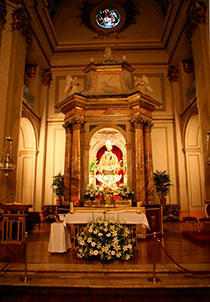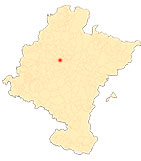The chapel of San Fermín
The neoclassical tabernacle
On 25 August 1816, the town councillors considered the need to build a new, decent tabernacle. The project, of neoclassical style with Italian influences, was the work of the sculptor Francisco Sabando and was executed with some modifications by Anselmo Salanova, a sculpture and painting teacher who lived in Pamplona, although the Italians Luis Boccia and Carlos Peduzzy, both from San Sebastián, were also partly involved. It was inaugurated for the Sanfermines of 1819. Initially planned in Aragon pine, it was finally made in painted stucco, in a mottled marble look. On the base, on which three altar tables are placed, eight columns support the dome, whose interior pendentives hold, as reliefs, four angels with episcopal attributes. A broken entablature runs above the columns; above the cornice, a bas-relief depicts the Mystic Lamb resting on the apocalyptic Book of the Seven Seals and adored by kneeling angels at either end. Finally, crowning the summit is an allegory of the Church between two flaming vases. The new position of the shrine, which was considerably moved back from the centre of the chapel and under its dome to the section of the chancel it now occupies, represents a radical change in the spatial conception, previously baroque and centred, in favour of a greater capacity to receive the faithful. Rationality thus replaces the emotional effect.
-
ANÓNIMO, Relación de las Plausibles Fiestas con que ha celebrado la Mui Noble i Mui Leal Ciudad de Pamplona, Cabeza del Ilmo. y Fidelissimo Reyno de Navarra, la Translación de su Gran patron saint San Fermín de la Antigua Capilla a la Nueva, que ha fabricado su devoción, Pamplona, Juan José Ezquerro, 1717.
-
GARCÍA GAINZA, M. C. and others, Catalog Monumental de Navarra, t. V***, Merindad de Pamplona. Pamplona. Indices generales, Pamplona, Government of Navarra, Archbishopric of Pamplona, University of Navarra, 1997, pp. 187-196.
-
MOLINS MUGUETA, J. L., Capilla de San Fermín en la iglesia de San Lorenzo de Pamplona, Pamplona, Diputación Foral de Navarra-Institución "Príncipe de Viana",Ayuntamiento de Pamplona, 1974.
-
MOLINS MUGUETA, J. L., El culto a San Fermín, in "Sanfermines. 204 horas de historia", Pamplona, Larrión y Pimoulier, 1992, pp. 31-39.
-
MOLINS MUGUETA, J. L., Las Capillas de San Fermín y Ntra. Sra. del Camino en Pamplona, in "El Arte en Navarra", no. 27, Pamplona , Diario de Navarra, 1995 , pp. 417-432.
-
On the website of the Chair de Patrimonio y Arte Navarro: An example of a "green man" in the Chapel of San Fermín in Pamplona, in "La pieza del mes", December 2013.












